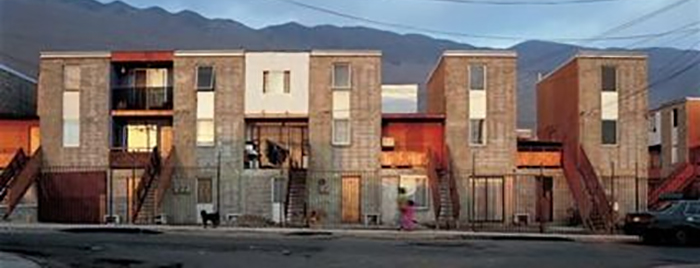Chilean architect Alejandro Aravena has won the world’s most prestigious architecture prize, the Pritzker. Aravena is based in Santiago de Chile where he has his architecture firm Elemental. They have been undertaking experimental urban interventions with a social purpose for fifteen years. Like a true Latin American revolutionary, Aravena says he is battling for a better built environmental for all.

Aravena, who sees “architecture as a shortcut to equality”, has also been chosen to direct this year’s Venice Architecture Biennale. Themed ‘Reporting from the Front‘ his aim is to promote front-line architecture – believing that architects should directly engage with social, political, environmental and economic challenges and through thoughtful deign, should empower citizens to become part of the process.
The international recognition of Aravena’s work is important for two reasons. First of all, it marks a significant ‘social turn’ that is taking place in architectural thinking and practice. Secondly it acknowledges the role of the global south in the development of architectural thought and practice.
The Pritzker tends to be a sign of the times. Zaha Hadid won in 2004, at the height of economic prosperity for the world’s major economies. It was a time when many architects, urban planners, politicians and mayors believed in the evangelistic power of statement architecture to stimulate the economic development of entire neighbourhoods. Hadid’s victory was a celebration of ostentatious buildings that have more interest in being seen on the world stage than paying attention to their local surroundings. But the age of high-profile Starchitects creating giant objects of consumerist desire is slowly being challenged. Now, post 2008, these top-down interventions are becoming less popular and there seems to be a shift to more frugal, piecemeal solutions that are a bit more humbling and a bit more local.
This is something that Aravena himself is very conscious of. In a recent article for The Guardian he talks about this paradigm shift: “Today, we understand better the sheer complexity of the issues at play when we design and plan buildings, neighbourhoods and even entire cities – and this demands a new, more open approach.”
The Pritzker jury chose Aravena because they see him as the leader of a new generation of socially minded architects. Similiarly Paolo Baratta, president of the Biennale, said Aravena was the best architect of this generation to address the fissure between architecture and social need: “This Biennale intends to react once again to the gap between architecture and civil society, which in recent decades has transformed architecture into spectacle on the one hand, yet made it dispensable on the other”.
Significantly, the recognition of Aravena celebrates approaches to design that do not emanate from the global north. Since the era of imperialist colonialism there has been a Western dominance over the design of buildings, neighbourhoods and cities across the globe. But Aravena is bringing to view the value of different approaches based on the southern context.
Elemental’s housing projects build on the informal, creative and resourceful housing typology that is more commonly found in poorer neighbourhoods of Latin America. One of their most famous projects is Quinta Monroy in Iquique, Chile. The 93 homes were designed in response to the need for well-designed affordable housing on a very small area of land where the residents previously had no legal land title. What made the houses innovative is that the architects only built a very modest structure for each family that would be financially viable and then let the residents do the rest themselves over time. Some added an extra floor for another member of the family, others created terraces and painted the facades in bright colours. Formalising their informal living conditions in this way enabled the residents to live in a less precarious environment whilst not imposing a new way of living onto the residents.

Houses built at Quinta Monroy in 2004. As first built and, below, as adapted by residents
Elemental refer to this approach as a more ‘incremental’ style of architecture where the power to shape peoples surroundings is taken away from the designers and their a priori visions, and put in the hands of the users who will develop the structures into the places that they want and need over time, with their own investment and without someone from outside dictating this for them.
Global models, styles and techniques for building places have rarely emerged from the global south because they have never been valued in the same way. What makes this work exciting is that this kind of incremental housing that celebrates local nuances has rarely been implemented at scale ‘on purpose’. It is exciting to have an influential Latin American architect calling for people to fight for better living conditions. Although I’m not convinced he would die for the cause, could he really be the Che Guevara of the architecture world? Ya veremos.

